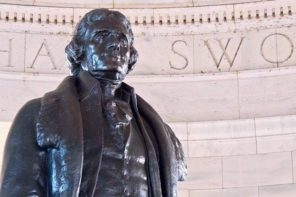The Westboro Baptist Church is back in the news. The threat that the church would engage in anti-gay picketing of the funerals of the victims of the shooting in Tuscon caused the Arizona legislature to quickly pass legislation prohibiting funeral protests. The legislation may well prove unconstitutional, though the basis on which the decision won’t be decided—the First Amendment’s free exercise clause—may come as a surprise to many observers. It may come as a surprise that, below the radar of most Americans, religion has lost its special status.
Sometime in the next few months, the Supreme Court will decide Snyder v. Phelps, an earlier Westboro Baptist Church case involving an anti-gay protest at a military funeral. In Snyder, the family of a deceased service member sued the church for violation of privacy based on a crudely anti-gay protest that church members held prior to the funeral. The family originally won a judgment of $7.9 million in compensatory and punitive damages, but that was reversed by the Fourth Circuit Court of Appeals on the ground of free speech. The Supreme Court is now reviewing that ruling, which will implicate the recent Arizona legislation as well.
No one can say, of course, which side will win the case—though most legal observers expect a victory for the free speech rights of the church. But we can already identify the loser: the free exercise clause.
While these protests do undoubtedly involve the principle of free speech, it would seem just as obvious that they also implicate the free exercise clause. The rhetoric of the church’s protests at military funerals (“God hates fags,” for example) clearly suggests a religious obligation to protest against gay rights. The free exercise clause of the First Amendment prohibits government—originally just the federal government, but now all government at all levels—from, well, prohibiting the free exercise of religion. At least arguably, the church’s claim sounds like it falls under this right.
And in fact the church did raise a free exercise claim in arguing Snyder, though the claim added nothing to the church’s defense. In fact, under current law, the church could not have a legitimate free exercise argument even though its free speech claim might be meritorious. How did we get to the point where the infringement of a religious obligation is constitutionally irrelevant despite the existence in the text of a constitutional protection of religion?
The answer to that question involves a 1990 decision written by Antonin Scalia in Employment Division v. Smith in which two drug counselors were fired from their jobs because they ceremonially ingested peyote in accordance with a well-recognized Native American religion. When they applied for unemployment compensation, they were ruled ineligible because they had engaged in misconduct. Smith upheld the denial of unemployment compensation.
Prior to Smith, the constitutional rule had been that if the government placed a substantial burden on the practice of religion, the government would have to provide what was called a “compelling government interest.” Granted, plaintiffs who challenged government regulations that burdened religion rarely succeeded in overturning the government regulation in question. Nevertheless, before Smith, it was clear, as Justice William Brennan wrote in a 1987 case, that “government may (and sometimes must) accommodate religious practices.”
But Justice Scalia did not hold in his opinion that the government had a compelling interest in the enforcement of its anti-drug policies. Instead, Justice Scalia held that there can never be a free exercise challenge against a generally applicable law; that is, a law that does not burden only religious practices. Since the anti-peyote laws in question applied to both religiously motivated and non-religiously motivated peyote use, the free exercise clause, in Scalia’s opinion, simply does not apply.
The Smith opinion faced two hurdles. First, as in the instance of the sacramental use of wine during Prohibition, government has often exempted generally applicable laws based on their effect on religious practices. It had always been assumed, as Justice Brennan stated, that at least on occasion such exemptions were mandated by the free exercise clause. Justice Scalia responded that although government is still free to grant such exemptions, government is never obligated to do so.
The second problem was that the Court had on several occasions previously granted exemptions to generally applicable laws that burdened religious practice. In perhaps the most famous such case, Wisconsin v. Yoder in 1972, the Court invalidated a compelled school attendance law for Amish parents who refused to send their children to high school on religious grounds.
Justice Scalia reinterpreted cases like Yoder as involving hybrid rights—in this case, parental rights—in conjunction with the free exercise claim. Of course, such reasoning renders the free exercise claim irrelevant, which is why the Westboro Church case will be decided strictly on free speech grounds and not as a free exercise case.
Smith was immediately unpopular and congressional efforts to overturn it by statute met with limited success, leaving federal government actions that substantially burden religious practice subject to the compelling state interest test, but state and local laws exempt. The funeral privacy interest in Snyder is a generally applicable law and the new anti-protest funeral provisions in Arizona are generally applicable as well.
Smith does not mark the end of religious liberty in America, of course. Since Smith, the Court has held that laws aimed specfically at religious practice will still be held unconstitutional and the court has continued to grant a certain institutional independence in cases solely involving religious institutions; such as the division of church property when denominations fracture.
Nevertheless, it is worth reflecting on why Smith was decided in the way that it was. Americans do have constitutional rights against even generally applicable laws, which is why Westboro Baptist Church may well win its claim to picket at funerals as a matter of free speech. Sometimes we have such rights even when the right in question is not in the text of the Constitution at all, as was true of the parental rights in Yoder. So, why is the free exercise clause a kind of lesser right?
Part of the reason is Justice Scalia’s fear of “courting anarchy” as society becomes more religiously diverse. There is no predicting what conduct a party may claim is religiously obligatory in the face of general societal and legal norms. In Smith, Justice Scalia produced a listing of some of the religious claims the court had previously confronted, including religious exemption from compulsory vaccination laws, drug laws, traffic laws, tax payments—even laws against child abuse—and wondered how the court can adjudicate among these religious claims.
The question is, however, whether the constitutional text does not require the courts to make just such difficult judgments. The framers of the Constitution thought religious liberty an especially important value and protected it in the text. By reading this protection to a certain extent out of the Constitution, Justice Scalia solved an admittedly difficult problem; but he did so by limiting Americans’ right to protected religious liberty. Even if parties usually lost their challenges prior to Smith, the government was still required to provide extraordinary justification before religious practices could be suppressed. Undoubtedly that pressure explains why governments often did grant exemptions favoring religious practices, including several states that exempt Native American Church use of peyote, from the reach of criminal laws prohibiting drug use.
On a deeper level, Smith can be read as endorsing the view that religious practice is just another form of conscience-driven conduct and should not be granted any special protection. Religious practice thus becomes enmeshed in a basically secular context—conscience—in which its unique demands are not acknowledged. Indeed, by implication, there are no unique religious demands that society is obligated to recognize, making Smith one more marker on the road to Charles Taylor’s secular age. One can praise it on the grounds that it protects religious believers and non-believers equally, but insofar as it establishes that religion is not unique, America has lost a protected space where the claims of the secular state could be resisted.




